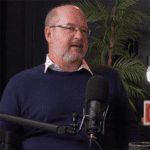

#73: Economic insights with Warren Hogan
In this podcast Warren Hogan, Managing Director of EQ Economics and Economic Advisor at Judo Bank, provides an in-depth analysis of Australia’s economic landscape and the rationale behind his views on interest rates and inflation.
Warren emphasizes the need for Australia’s cash rate to surpass 4% in order to achieve a zero real interest rate. He argues that negative real interest rates historically do not help control inflation and can even contribute to its rise. By maintaining a zero real interest rate, Hogan believes the country can achieve a soft landing and effectively manage inflation.
Despite concerns about a potential economic downturn, the Australian economy has shown resilience Warren says and he also mentions interactions with mid-sized companies and their positive outlook, indicating that business activity remains strong. Adding recent employment data and member feedback showing that businesses are still hiring due to labor shortages.
Warrens shared his view that the cash rate could reach 4.35% or possibly 4.6% by the end of September. However, suggesting that once this target is achieved, there should be a genuine pause of four to six months to observe the effects of previous rate hikes. This pause period would allow the economy to stabilize and inform future monetary policy decisions.
This podcast is highly recommend listening, giving a comprehensive providing valuable perspectives and insights into Australia’s economic outlook and the role of interest rates and other economic levers in managing inflation.
Stephanie: Welcome to TEC Live, Stephanie Christopher here, CEO of the Executive Connection. We connect leaders with a trusted network of people who help them succeed. So my guest today is Warren Hogan, who really needs no introduction, but I’ll do one anyway. So Warren is the managing director and founder of EQ Economics, a consultancy that specializes in economic, market and industry analysis. Warren’s an economic advisor to Judo Bank, which is a specialist SME focused lender. Warren’s also a regular in Australian and international media, a columnist for the Australian Financial Review and a contributor to Sky News Australia. Warren’s focus is on the Australian economy and supporting business decision-making. And Warren Hogan, welcome to TEC Live.
Warren: Thanks for having me, Stephanie. Good to be back with you.
Stephanie: Yes, this must be about number three.
Warren: Yes. Yes. It’s been a while though.
Stephanie: It has been a while. Okay. So you and I have spoken in the interim and you’ve talked about interest rates, and I know that you were speaking very clearly maybe a year ago saying interest rates need to go up. And before we start, let me timestamp this podcast. Today’s the 19th of June 2023. It’s relevant I think when we’re talking about the economy because it’s all changing so quickly. So back to interest rates. Has your position changed at all?
Warren: No. No. It’s pretty much the same as it’s been for the last year when I first had this view that Australia’s cash rate has to get over 4%. It was based on some simple economic arithmetic, and that is we should be able to get inflation down to about 4%. It peaked at just under eight and is now looking like it’s around six. Yeah, it’s a good bit under, and it should come down to four. It obviously needs to get down to three, even a little bit below over the next few years.
And my view then was and has always been that if you can get the cash rate up to around four, what that gives you is a zero real interest rate. The real interest rate is simply the interest rate minus inflation. And the reason you need a zero real interest rate as opposed to a deeply negative one is there’s no historical precedent for getting inflation under control with negative real interest rates. In fact, that’s usually what causes inflation. So that was our first port of call as an economy was to get those interest rates up so that they weren’t in negative territory in real terms. And of course-
Stephanie: And you even argued that the Reserve bank was a little slow to do that.
Warren: Yeah. Look, I thought they started well. They pivoted, which was moving from 50s to 25s in late ’22 quite well. And that’s because we have so much variable rate lending in this economy, not just for the households and mortgages, but also for business that they needed to give everyone a chance. It was just unfair in a way. So they pivoting down to 25s. But of course when you do that and you’ve still got to raise rates a fair bit, it means you had to keep going. And I think when we got back from our summer holidays this year, really, it was clear to me that this economy was still very strong. And of course, the thing that a lot of economists were worried about was the economy was about to roll over on the next interest rate, can tumble into recession. And I just never felt that was the right way to think about it.
I was always worried about resilience, that the economy was actually doing well and I spent my time speaking to midsize companies, whether through tech or through Judo. And everything they was telling me was that yes, things had slowed down a bit, but business was by and large doing well. So we’ve now got the cash rate over four and the governor’s terms coming up in a few months. And the 435 forecast I had looks about right, whether it’s 4.35 or 4.6, but now what you’re seeing, especially in the last week with that very strong employment number that we got for May where we had 76,000 jobs in the month, which is massive. I mean, it’s just blew everything away. It highlights again that businesses are hiring and-
Stephanie: We’re hearing it from our members.
Warren: Yeah.
Stephanie: They’re still hiring. Yeah.
Warren: And part of the reason is because of labour shortages, which are everywhere.
Stephanie: Yes.
Warren: Yeah, there’s just this backlog of vacancies whether you can find the right person. I think one thing in 23 businesses have got a lot more acutely aware of is hiring the right people. I think there was a lot of hiring of just whoever in ’22 and there was a lot of bad experience and probably asking too much of people and so forth. So anyway, we’ve got this very strong employment number reflects still resilience in the economy. And now all the economists which had been saying the RBA wouldn’t go beyond a 3% cash rate or whatever, constantly chasing their tail and now talking about a 4.85 or a 5% cash rate. And I think while of course there is this risk that we have to keep going, I still think the right view is that the cash rate goes up to 4.35 or maybe 4.6 when the governor finishes his term in September and then they sit back and have a genuine pause.
Now, for me, a pause is four to six months where they can sit back, not move the rate and observe on the economy or the effects of all the past rate hikes. Back in April when they decided not to move, that’s not a real pause, that was just a reprieve.
Stephanie: Yep.
Warren: So I think that review is the right one, but of course, I’m just sticking to my view and my arithmetic and my economic models that tell me that we should get this soft landing with a zero real interest rate as I’ve been talking about. Plus also the fact that interest rates are up 400 basis points, 4% in the last year. That’s a phenomenal increase, that hits cash flows of households, of business. And I think the combination of those two analytics tell us this is the right level, but of course the economy has to slow.
And an important part of that is employment, because one of the basics of macroeconomics is that when people have jobs and more and more people have jobs and their incomes are going up and wages are now growing, that there’s going to be spending in the economy, and it’s very hard to slow the economy. The other curve ball has been the big increase in population growth in the last nine months. Since the new government got in, they’ve really fast tracked these visa approval processes, which were slowing things down previously. And of course the budget confirmed the big numbers that are now coming through. And of course, that adds demand to the economy.
Stephanie: Boy, there’s a balance, isn’t it?
Warren: Yeah.
Stephanie: Because the things you’re talking about, putting a naive listener hat on here, they sound like good things. People are in work, people are getting paid more.
Warren: Yeah, and they are good things. And the problem is that in 2023, good news on the economy is actually bad news for inflation and interest rates. We do need to slow the economy down. We need to give the demand in the economies chased ahead of the supply, whether it’s in terms of the potential labor supply or constraints we’re seeing in certain industries such as construction, we need to slow that demand down for a period of 6, 9, 12 months and allow the supply to catch up. And of course, this involves interest rates going up to what is a more normal and appropriate level. And this is one of the big misconceptions in the broader community that, because we live and breathe interest rates is what happens when they change because we have to pay more on our mortgages or what have you. People think that the change in interest rates what’s matters. It does matter of course, but the reality is that for a given economic situation, it’s a level that you have to be at.
And part of the reason rates have gone up so much is just as much because they were so low before. And that’s the problem, if you will. I mean, we’ve gone from zero interest rates, something this country’s never seen before ever to one of the worst inflations in generations. And that that’s a diabolical combination. And the reality is if we can get this inflation down without a recession, it’ll be just another Australian economic miracle that we’ve actually seen a few of them in the last 20 years.
Stephanie: Yeah. What’s the unfortunate endpoint of completely out of control inflation?
Warren: Well, inflation not only is a problem now in the sense that it’s undermining living standards for all Australians, it hurts those with the least financial flexibility. So obviously retirees on fixed incomes or low income earners or people who have little bargaining power in their workplace. And that in itself is now getting to such a degree where, well, I’m pretty confident to say that for the bottom 50% of income earners in Australia, their living standards have essentially taken a 10-year backwards step. The real interest rate’s gone down that much. And if this continues, then not only is it terrible for those people, but I think it’s bad for our community from a cohesion, a stability sense, and ultimately from a political harmony sense. So that’s the problem with it in the short term, and I think that’s a good enough reason to get rid of it.
But in the long term, inflation undermines the functioning of the economy. It stops businesses investing in the right things. It’s more investment dollars tend to go to more speculative assets like property, away from things like investing in new plant equipment.
Stephanie: R&D.
Warren: R&D, all the things that have ultimately raised productivity. And so the performance of the economy is jeopardized in the medium to long term. Now, the sting in the tail here is that in the short term, when inflation first emerges, there’s a lot of beneficiaries. The government and their revenues, banks, big business, even mid-size companies. The losers are households. The winners are everyone else, in the short term. And of course this makes it not seem like such a big problem for many important people in our community. And of course, this eventually goes the other way as the economy’s performance is undermined, both in terms of that story about productivity and investment or in terms of social cohesion.
Stephanie: And where are we now in that?
Warren: Well, we’re in the very early stages. So you can see the Treasury Secretary licking his lips because he is getting all these revenues. He knows better. Of course, you’d hope so anyway. But we’re still in that phase where it’s a benefit to business and it’s hurting households. That’s starting to shift predominantly because wages are starting to now go up. We saw the Fair Work Commission’s minimum wage increase of 8.6%, which is phenomenally being now only 184,000 workers are on the minimum wage. So it’s not that material.
Stephanie: But it was a signal, wasn’t it?
Warren: It was a signal. And then the other 20% of modern awards that the Fair Work Commission has direct jurisdiction over had a 5.75% increase. And that’s the signal for me. And 5.75 is not sustainable. It’s sustainable right now. It’s not sustainable over the long term. The metric is at best three and a half wages will give us our inflation of about two and a half percent. So the economy is out of whack. Things at the surface look good from an activity, from a cashflow perspective, but that will all change.
And of course, ultimately interest rates will go up even further. Now, even if the RBA doesn’t respond, what people are willing to borrow and lend and save at will all shift. Because at the moment, even though there’s some of the best term deposits on offer that anyone’s seen for a decade at say 5%, that’s about as good as you’re going to get at Judo Bank or any other bank. But even at 5% with six or 7% inflation, you’re still going backwards. And at the moment, there’s a bit of an illusion. People probably don’t overread that, but doesn’t take long before … especially retirees where that’s their income. So really, actually, I’m not going anywhere. My grocery basket cost me 50% more than it did two years ago, so I might be earning 5% and my income might’ve gone up a bit, but not enough to cope with that. So interest rates eventually go up. And of course, what we now know clearly from the 1970s when we let inflation go, when we didn’t nip it-
Stephanie: How hard did it get in the ’70s?
Warren: Oh, most countries of the world got up to 15, 20%.
Stephanie: Yeah, right.
Warren: Yeah. Not every year, year in and year out. But in the late ’70s at the peak, and it was … I’m guessing here, but I’m probably as good as anyone to guess it, but I think inflation probably averaged in places like Australia and the United States, UK around six or 7% a year for a decade. And that’s way too high and completely unsustainable. But the problem was, was it did get away and the United States had to go through two deep damaging recessions. One in 1979, one in 1982. In Australia, we had one in 1982 that was quite severe, that didn’t get the job done. We had to have a full blown financial crisis in the early ’90s with an 11% unemployment rate to get rid of that inflation. And for me, as the economist, my offering to the rest of the community is, while it seems all and well now and these interest rate hikes to deal with seem painful, it’s nothing compared to what we’ll have to do in three, four, five years time or later if we let it get-
Stephanie: If we don’t get on top of it.
Warren: The real recession, the recession that no one will ever forget is when banks have such big losses that they’re unable to lend money into the economy. And that’s when good businesses fail. When a short term liquidity problem turns into a failure, even businesses with a future, if the banks don’t have the money or aren’t prepared to lend it, then that’s the problem. We just got to avoid that at all costs. It’s been a big part of my motives for being quite a strong voice on why the RBA needed to get on with it. But I think we’re getting there and I think the RBA knows exactly what they’re doing.
Stephanie: Well, that’s good to hear. That’s positive. And so you’ve said that there might be an economic miracle here. What’s the likelihood that we avoid recession? Are the countries very close to us already in recession or what’s the likelihood do you think that we can avoid it?
Warren: Well, we’ve got to really get clear and our leaders, senior journalists, people like me need to explain that there’s a difference between a mild technical recession and a bad recession. We all naturally, people with experience in business know the difference. It’s that difference between your revenues falling out off a cliff and having to lay off staff and some businesses failing and a slow patch. So I don’t think we’re going to avoid a technical recession. It will be beyond a miracle if we avoid that. But two quarters of negative economic growth, mild falls, I don’t think is a big deal as long as it’s shallow and short-lived, and the recovery can commence before long.
So look, I think what you’re really asking is, what’s the chances of that bad recession? And at the moment, I still think it’s quite low, one in five, 20%, but we’re moving in that direction. As I said, good news on the economy in 2023 is bad news on inflation and interest rates. And then also that probability of a hard landing or a deeper recession. And that’s why you’ve seen in the past week or so when we had those very strong employment numbers, the tone really shifted out there because a lot of economists were like, ‘Oh, well …’ These were economists who thought the economy was going to fall over at a 3% cash rate or a three and a half percent cash rate. They’re now saying, ‘Well, it could go up to 4.6 or 4.85.’ And of course, in their minds, that raises the chance of that hard landing.
In my mind, we don’t get that bad recession until the cash rate gets up to five and a half, six. I think that five and a half, six level is equivalent of the 16, 17% of the late 1980s. We’re never going to get anywhere near that.
Stephanie: Good.
Warren: We’ve got too much doubt in our community and the damage is done when interest rates go to, if they went to five and a half, six in the next couple of years would be. I don’t think it would be a financial crisis, banks are in pretty good shape, but it would be a deep recession. One we should avoid.
Stephanie: Okay, Aussie, just because you hear, what about the dollar?
Warren: Look, it’s rallied on the back of the RBA, getting on with it. Again, that’s sort of a reflection of how other people’s views have shifted. But the big picture on the Aussie dollar is that the two main factors that drive it, one is commodity prices. They’re very high. In fact, if that was the only thing that mattered, our currency would be up near parity with the US dollar just like it was 12, 13, 14 years ago.
Stephanie: The good old days. Yeah.
Warren: Yeah. Well, it was good if you’re traveling.
Stephanie: Yeah.
Warren: But then the other key factor, which is relevant for all currencies, all economies, is the interest rate differential between us and the global rate, which is best measured as the US interest rate. And right now, it is deeply negative. Our interest rate at 4.1% compares to a US interest rate of 5.25%, and that’s what we’ve seen in the last month or so is the biggest negative interest rate differential ever. And just some basic modeling would say that the Aussie dollars should be at 50 cents. And typically in history, the two factors move in line. When commodities are doing well, Australia’s doing well and our rates are higher than US rates and vice versa. So for the first time in 40 years since the Aussie has been floated, they’re going in very different directions. So the question really is, how will this be resolved?
And I’m not sure is the answer, but we have certainly got an RBA that’s more willing to raise rates. We’ve got a US Federal Reserve that seems to be on pause. They passed the opportunity last week to raise rates, so they might be near the end of it. So that’s why the Aussies had some support in the past week. But I do worry that if the world economy slows down, commodity prices will come down. So look, I could give you a view, but at the moment, I’m happy to say for anyone doing business, don’t let the level of the currency get in your way.
Whether you want to hedge your Aussie dollar exposure for imports or exports, that’s really a business decision. I don’t see a compelling need to, from a view point of view. If you want to buy business overseas, then I don’t think the Aussie dollars should get in your way. I think it’ll actually be pretty range bound that is move around this sort of 65 to 75 level for a while. What’s the next big move? I do worry that it’s downwards. A global slowdown. There could be something nasty on the horizon two or three years down the track, but I really don’t know. So at the moment, I think you treat the Aussie dollar as being fair value and don’t let it get in the way of what you’re doing.
Stephanie: It’s good tip. So this is what I like about Warren. Calm, confident, optimistic. It’s factual. You know what you’re talking about. You’re extremely credible and you’re always good to chat to. And can we have you back again soon because things are moving quickly, but a great summary of where we are as of today in Australia. Warren Hogan, thank you for joining us on TEC Live.
Warren: Thanks, Stephanie. It’s been great to be with you.
Stephanie: So that’s TEC Live for today. CEOs are in the business of making decisions, and leadership is the art of execution. I’m Stephanie Christopher and look forward to talking to you next time.




